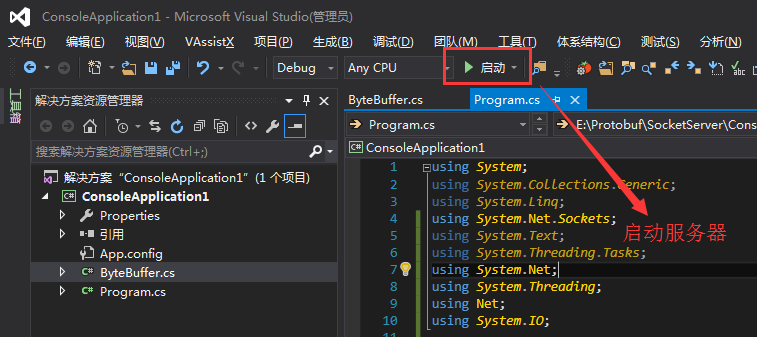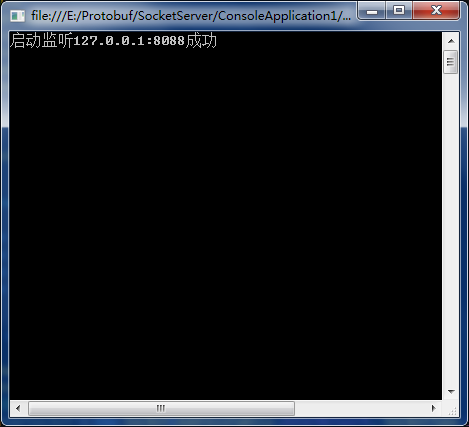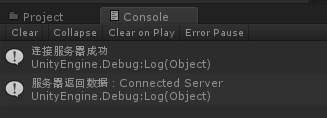前言:
在开始编写代码之前,我们首先需要明确:联网方式、联网步骤、数据收发以及协议数据格式
当然在设计时也应该减低代码的耦合性,尽量使得网络层可以在其他地方进行复用,这就需要我们进行接口式的开发。我们这里使用的通信模式是Socket强连接的通信方式,并且使用C#作为编程语言,其实与.NET的Socket通信是一致的。
一、设计思想:
为了方便测试,我直接使用C#写的一个控制台应用,作为服务器,等待客户端的连接,然后使用Unity建立Socket客户端去连接服务器,进行简单的数据通信。这么设计的原因是都基于.net进行开发,也方便理解。
二、实现步骤:
对于网络通信有所了解的都应该知道,数据在网络传输的格式必须以字节流的形式进行,那么免不了要对字节流进行写入和读出操作,为了方便后面的操作,我们有必要封装一个读写字节流的操作类,在这里我定义了一个字节流的操作类ByteBuffer类,用于将各个类型数据写入流中,也可从字节流中读取各种类型的数据:
using System.IO;
using System.Text;
using System;
namespace Net {
public class ByteBuffer {
MemoryStream stream = null;
BinaryWriter writer = null;
BinaryReader reader = null;
public ByteBuffer() {
stream = new MemoryStream();
writer = new BinaryWriter(stream);
}
public ByteBuffer(byte[] data) {
if (data != null) {
stream = new MemoryStream(data);
reader = new BinaryReader(stream);
} else {
stream = new MemoryStream();
writer = new BinaryWriter(stream);
}
}
public void Close() {
if (writer != null) writer.Close();
if (reader != null) reader.Close();
stream.Close();
writer = null;
reader = null;
stream = null;
}
public void WriteByte(byte v) {
writer.Write(v);
}
public void WriteInt(int v) {
writer.Write((int)v);
}
public void WriteShort(ushort v) {
writer.Write((ushort)v);
}
public void WriteLong(long v) {
writer.Write((long)v);
}
public void WriteFloat(float v) {
byte[] temp = BitConverter.GetBytes(v);
Array.Reverse(temp);
writer.Write(BitConverter.ToSingle(temp, 0));
}
public void WriteDouble(double v) {
byte[] temp = BitConverter.GetBytes(v);
Array.Reverse(temp);
writer.Write(BitConverter.ToDouble(temp, 0));
}
public void WriteString(string v) {
byte[] bytes = Encoding.UTF8.GetBytes(v);
writer.Write((ushort)bytes.Length);
writer.Write(bytes);
}
public void WriteBytes(byte[] v) {
writer.Write((int)v.Length);
writer.Write(v);
}
public byte ReadByte() {
return reader.ReadByte();
}
public int ReadInt() {
return (int)reader.ReadInt32();
}
public ushort ReadShort() {
return (ushort)reader.ReadInt16();
}
public long ReadLong() {
return (long)reader.ReadInt64();
}
public float ReadFloat() {
byte[] temp = BitConverter.GetBytes(reader.ReadSingle());
Array.Reverse(temp);
return BitConverter.ToSingle(temp, 0);
}
public double ReadDouble() {
byte[] temp = BitConverter.GetBytes(reader.ReadDouble());
Array.Reverse(temp);
return BitConverter.ToDouble(temp, 0);
}
public string ReadString() {
ushort len = ReadShort();
byte[] buffer = new byte[len];
buffer = reader.ReadBytes(len);
return Encoding.UTF8.GetString(buffer);
}
public byte[] ReadBytes() {
int len = ReadInt();
return reader.ReadBytes(len);
}
public byte[] ToBytes() {
writer.Flush();
return stream.ToArray();
}
public void Flush() {
writer.Flush();
}
}
}
使用此操作类进行读写数据的操作范例如下:
- 读取数据:
//result是字节数组byte[],从中读取两个int类型的数据
ByteBuffer buff = new ByteBuffer(result);
int len = buff.ReadShort();
int protoId = buff.ReadShort();- 写入数据:
//result是字节数组byte[],从写入两个不同类型的数据
ByteBuffer buff = new ByteBuffer();
int protoId = ProtoDic.GetProtoIdByProtoType(0);
buff.WriteShort((ushort)protoId);
buff.WriteBytes(ms.ToArray());
byte[] result = buff.ToBytes();
1.服务器创建:
在VS中新建一个C#控制台应用,新建项目完成后将上面定义的ByteBuffer.cs类导入工程中,然后开始在入口类Program中开始创建Socket服务器的逻辑。
先引入必要的命名空间:
using System.Net;
using System.Net.Sockets;
using System.Threading;基本的步骤如下:
- 创建一个服务器Socket对象,并绑定服务器IP地址和端口号;
private const int port = 8088;
private static string IpStr = "127.0.0.1";
private static Socket serverSocket;
static void Main(string[] args)
{
IPAddress ip = IPAddress.Parse(IpStr);
IPEndPoint ip_end_point = new IPEndPoint(ip, port);
//创建服务器Socket对象,并设置相关属性
serverSocket = new Socket(AddressFamily.InterNetwork, SocketType.Stream, ProtocolType.Tcp);
//绑定ip和端口
serverSocket.Bind(ip_end_point);
//设置最长的连接请求队列长度
serverSocket.Listen(10);
Console.WriteLine("启动监听{0}成功", serverSocket.LocalEndPoint.ToString());
}完成上述代码之后,已经能正常启动一个服务器Socket,但是还没有处理连接监听逻辑和数据接收,所以运行应用会出现一闪就关掉的情况。
- 启动一个线程,并在线程中监听客户端的连接,为每个连接创建一个Socket对象;
- 创建接受数据和发送数据的方法。
完整的代码如下:
using System;
using System.Collections.Generic;
using System.Linq;
using System.Net.Sockets;
using System.Text;
using System.Threading.Tasks;
using System.Net;
using System.Threading;
using Net;
using System.IO;
namespace ConsoleApplication1
{
class Program
{
private static byte[] result = new byte[1024];
private const int port = 8088;
private static string IpStr = "127.0.0.1";
private static Socket serverSocket;
static void Main(string[] args)
{
IPAddress ip = IPAddress.Parse(IpStr);
IPEndPoint ip_end_point = new IPEndPoint(ip, port);
//创建服务器Socket对象,并设置相关属性
serverSocket = new Socket(AddressFamily.InterNetwork, SocketType.Stream, ProtocolType.Tcp);
//绑定ip和端口
serverSocket.Bind(ip_end_point);
//设置最长的连接请求队列长度
serverSocket.Listen(10);
Console.WriteLine("启动监听{0}成功", serverSocket.LocalEndPoint.ToString());
//在新线程中监听客户端的连接
Thread thread = new Thread(ClientConnectListen);
thread.Start();
Console.ReadLine();
}
/// <summary>
/// 客户端连接请求监听
/// </summary>
private static void ClientConnectListen()
{
while (true)
{
//为新的客户端连接创建一个Socket对象
Socket clientSocket = serverSocket.Accept();
Console.WriteLine("客户端{0}成功连接", clientSocket.RemoteEndPoint.ToString());
//向连接的客户端发送连接成功的数据
ByteBuffer buffer = new ByteBuffer();
buffer.WriteString("Connected Server");
clientSocket.Send(WriteMessage(buffer.ToBytes()));
//每个客户端连接创建一个线程来接受该客户端发送的消息
Thread thread = new Thread(RecieveMessage);
thread.Start(clientSocket);
}
}
/// <summary>
/// 数据转换,网络发送需要两部分数据,一是数据长度,二是主体数据
/// </summary>
/// <param name="message"></param>
/// <returns></returns>
private static byte[] WriteMessage(byte[] message)
{
MemoryStream ms = null;
using (ms = new MemoryStream())
{
ms.Position = 0;
BinaryWriter writer = new BinaryWriter(ms);
ushort msglen = (ushort)message.Length;
writer.Write(msglen);
writer.Write(message);
writer.Flush();
return ms.ToArray();
}
}
/// <summary>
/// 接收指定客户端Socket的消息
/// </summary>
/// <param name="clientSocket"></param>
private static void RecieveMessage(object clientSocket)
{
Socket mClientSocket = (Socket)clientSocket;
while (true)
{
try
{
int receiveNumber = mClientSocket.Receive(result);
Console.WriteLine("接收客户端{0}消息, 长度为{1}", mClientSocket.RemoteEndPoint.ToString(), receiveNumber);
ByteBuffer buff = new ByteBuffer(result);
//数据长度
int len = buff.ReadShort();
//数据内容
string data = buff.ReadString();
Console.WriteLine("数据内容:{0}", data);
}
catch (Exception ex)
{
Console.WriteLine(ex.Message);
mClientSocket.Shutdown(SocketShutdown.Both);
mClientSocket.Close();
break;
}
}
}
}
}
2.客户端创建:
客户端连接服务器的逻辑相对简单一些,跟服务器一样,先把ByteBuffer类导入到工程中,基本步骤如下:
- 创建一个Socket对象,这个对象在客户端是唯一的,可以理解为单例模式;
- 使用上面创建Socket连接指定服务器IP和端口号;
- 接收服务器数据和发送数据给服务器。
先创建一个ClientSocket类用于管理Socket的一些方法:连接服务器、接受数据和发送数据等:
using UnityEngine;
using System.Collections;
using System.Net;
using System.Net.Sockets;
using System.IO;
namespace Net
{
public class ClientSocket
{
private static byte[] result = new byte[1024];
private static Socket clientSocket;
//是否已连接的标识
public bool IsConnected = false;
public ClientSocket(){
clientSocket = new Socket(AddressFamily.InterNetwork, SocketType.Stream, ProtocolType.Tcp);
}
/// <summary>
/// 连接指定IP和端口的服务器
/// </summary>
/// <param name="ip"></param>
/// <param name="port"></param>
public void ConnectServer(string ip,int port)
{
IPAddress mIp = IPAddress.Parse(ip);
IPEndPoint ip_end_point = new IPEndPoint(mIp, port);
try {
clientSocket.Connect(ip_end_point);
IsConnected = true;
Debug.Log("连接服务器成功");
}
catch
{
IsConnected = false;
Debug.Log("连接服务器失败");
return;
}
//服务器下发数据长度
int receiveLength = clientSocket.Receive(result);
ByteBuffer buffer = new ByteBuffer(result);
int len = buffer.ReadShort();
string data = buffer.ReadString();
Debug.Log("服务器返回数据:" + data);
}
/// <summary>
/// 发送数据给服务器
/// </summary>
public void SendMessage(string data)
{
if (IsConnected == false)
return;
try
{
ByteBuffer buffer = new ByteBuffer();
buffer.WriteString(data);
clientSocket.Send(WriteMessage(buffer.ToBytes()));
}
catch
{
IsConnected = false;
clientSocket.Shutdown(SocketShutdown.Both);
clientSocket.Close();
}
}
/// <summary>
/// 数据转换,网络发送需要两部分数据,一是数据长度,二是主体数据
/// </summary>
/// <param name="message"></param>
/// <returns></returns>
private static byte[] WriteMessage(byte[] message)
{
MemoryStream ms = null;
using (ms = new MemoryStream())
{
ms.Position = 0;
BinaryWriter writer = new BinaryWriter(ms);
ushort msglen = (ushort)message.Length;
writer.Write(msglen);
writer.Write(message);
writer.Flush();
return ms.ToArray();
}
}
}
}
三、样例测试:
1.客户端测试:
在Unity中写一个测试脚本TestSocket.cs,并将此脚本绑到当前场景的相机上:
using UnityEngine;
using System.Collections;
using Net;
public class TestSocket : MonoBehaviour {
// Use this for initialization
void Start () {
ClientSocket mSocket = new ClientSocket();
mSocket.ConnectServer("127.0.0.1", 8088);
mSocket.SendMessage("服务器傻逼!");
}
// Update is called once per frame
void Update () {
}
}
2.启动服务器:
在Visual Studio中点击运行按钮,启动服务器:
启动正常的话,会弹出一个窗口如下图所示:
3.开始连接:
在Unity中运行当前场景,查看输出日志,假如连接成功,输出如下:
查看服务器窗口,发现双向通信都正常:
四、总结:
这里测试案例其实很简单,协议没有进行如何优化,单纯地发送字符串数据而已,假如针对复杂的数据的话,需要创建完整打包和解包协议数据的机制,而且必要时还需要对数据进行加密操作。
微信公众号「何乐不为呢」,一个码农的技术笔记和唠叨。





























 2382
2382











 被折叠的 条评论
为什么被折叠?
被折叠的 条评论
为什么被折叠?








